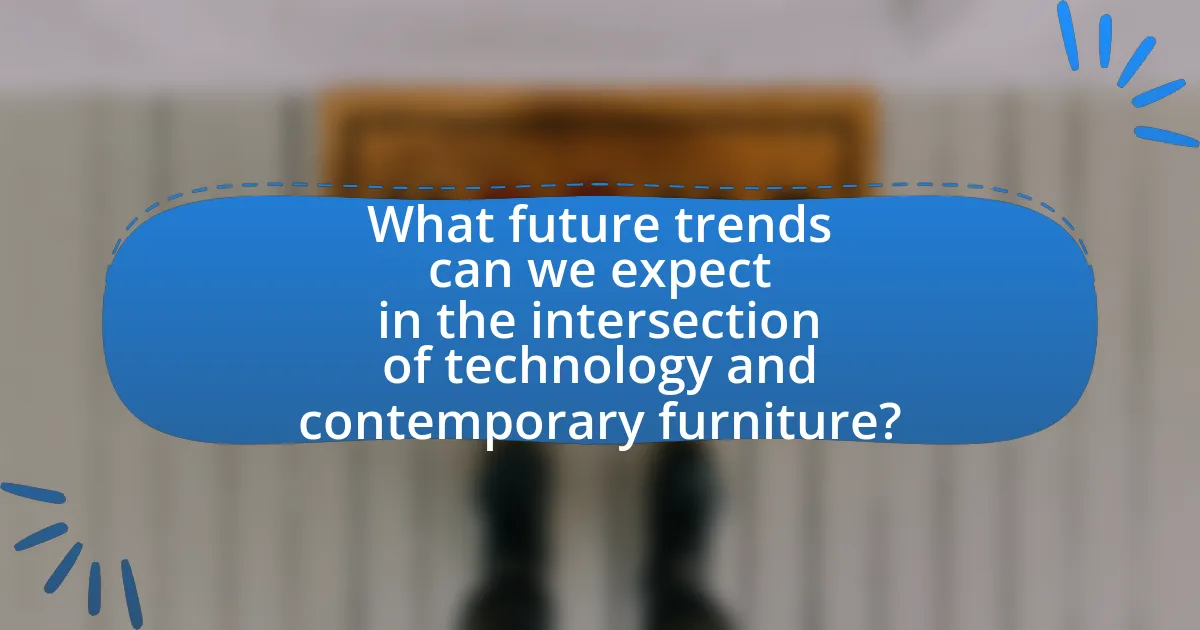The article examines the significant role of technology in shaping contemporary furniture design and production. It highlights how advancements such as computer-aided design (CAD), 3D printing, and smart technology integration enhance creativity, functionality, and sustainability in furniture. Key topics include the impact of digital tools on design efficiency, the transformation of materials through innovative manufacturing techniques, and the influence of smart furniture on consumer experience. Additionally, the article discusses challenges in integrating technology and future trends that will continue to evolve the furniture industry.

What is the Role of Technology in Shaping Contemporary Furniture?
Technology plays a crucial role in shaping contemporary furniture by enabling innovative designs, enhancing functionality, and improving manufacturing processes. Advanced technologies such as computer-aided design (CAD) and 3D printing allow designers to create complex shapes and structures that were previously impossible, leading to unique and customizable furniture pieces. Additionally, smart technology integration, such as IoT devices, enhances user experience by providing features like adjustable settings and energy efficiency. The use of sustainable materials and production methods, facilitated by technology, also aligns with contemporary consumer preferences for eco-friendly products. For instance, a report by the Furniture Industry Research Association highlights that 3D printing can reduce waste by up to 90% compared to traditional manufacturing methods, demonstrating technology’s impact on sustainability in furniture design.
How has technology influenced the design of contemporary furniture?
Technology has significantly influenced the design of contemporary furniture by enabling innovative materials, advanced manufacturing techniques, and enhanced functionality. For instance, the use of computer-aided design (CAD) software allows designers to create complex shapes and structures that were previously difficult to achieve, resulting in more ergonomic and aesthetically pleasing furniture. Additionally, advancements in materials such as engineered wood, metal alloys, and sustainable composites have led to lighter, stronger, and more environmentally friendly products. The rise of 3D printing technology has also revolutionized furniture design, allowing for rapid prototyping and customization, which caters to individual consumer preferences. These technological advancements not only improve the quality and durability of furniture but also expand the possibilities for creativity and personalization in contemporary design.
What are the key technological advancements impacting furniture design?
Key technological advancements impacting furniture design include 3D printing, smart technology integration, and sustainable materials. 3D printing allows for rapid prototyping and customization, enabling designers to create complex shapes and reduce waste. Smart technology integration, such as IoT devices, enhances functionality by allowing furniture to interact with users and their environments, exemplified by smart desks that adjust height automatically. Sustainable materials, including recycled plastics and bamboo, are increasingly used to meet consumer demand for eco-friendly products, reflecting a shift towards sustainability in design practices. These advancements collectively transform the furniture industry by improving efficiency, functionality, and environmental responsibility.
How do digital tools enhance creativity in furniture design?
Digital tools enhance creativity in furniture design by enabling designers to visualize concepts, experiment with materials, and streamline the prototyping process. Software such as CAD (Computer-Aided Design) allows for precise modeling and manipulation of designs, facilitating innovative shapes and structures that may be difficult to achieve manually. Additionally, 3D printing technology permits rapid prototyping, enabling designers to create and test physical models quickly, which fosters experimentation and iteration. Research indicates that the integration of digital tools in design processes can lead to a 30% increase in design efficiency and creativity, as reported in a study by the University of Cambridge, highlighting the significant impact of technology on contemporary furniture design.
What materials are being transformed by technology in furniture making?
Technology is transforming materials such as wood, metal, plastic, and textiles in furniture making. Advanced manufacturing techniques, including CNC machining and 3D printing, enhance the precision and customization of wood and metal, allowing for intricate designs and efficient production. Additionally, innovations in synthetic materials and smart textiles enable the creation of furniture that is not only aesthetically pleasing but also functional, such as self-cleaning surfaces and integrated technology. These advancements reflect a significant shift in how traditional materials are utilized, leading to more sustainable and versatile furniture solutions.
What are the benefits of using smart materials in furniture?
The benefits of using smart materials in furniture include enhanced functionality, improved durability, and increased user comfort. Smart materials can adapt to environmental changes, such as temperature and humidity, which allows furniture to maintain optimal conditions for users. For instance, phase-change materials can absorb and release heat, providing thermal comfort. Additionally, smart materials often possess self-healing properties, which extend the lifespan of furniture by repairing minor damages automatically. Research indicates that the integration of smart materials can lead to more sustainable furniture design, as they often require less maintenance and can reduce waste over time.
How does technology enable sustainable material choices in furniture production?
Technology enables sustainable material choices in furniture production by facilitating the use of eco-friendly materials and optimizing manufacturing processes. Advanced software and data analytics allow designers to assess the environmental impact of various materials, leading to informed decisions that prioritize sustainability. For instance, technologies like 3D printing enable the use of biodegradable materials and reduce waste by producing only what is necessary. Additionally, innovations in material science, such as the development of composite materials made from recycled products, further enhance sustainability. According to a study by the Ellen MacArthur Foundation, the circular economy model, supported by technology, can significantly reduce resource consumption and waste in furniture production.
How does technology affect the manufacturing process of contemporary furniture?
Technology significantly enhances the manufacturing process of contemporary furniture by improving efficiency, precision, and customization. Advanced machinery, such as CNC routers and 3D printers, allows for intricate designs and faster production times, reducing labor costs and material waste. For instance, CNC technology can cut materials with high accuracy, ensuring that components fit together seamlessly, which is crucial for modern furniture aesthetics. Additionally, software tools for design and simulation enable manufacturers to visualize products before production, minimizing errors and optimizing resource use. This integration of technology not only streamlines operations but also meets the growing consumer demand for personalized furniture solutions, as manufacturers can easily adjust designs based on customer preferences.
What role do automation and robotics play in furniture manufacturing?
Automation and robotics significantly enhance efficiency and precision in furniture manufacturing. These technologies streamline production processes by automating repetitive tasks such as cutting, assembling, and finishing, which reduces labor costs and minimizes human error. For instance, the use of CNC (Computer Numerical Control) machines allows for precise cuts and designs, improving product quality and consistency. According to a report by the International Federation of Robotics, the adoption of industrial robots in manufacturing has increased productivity by up to 30%, demonstrating their critical role in modern furniture production.
How has 3D printing changed the landscape of furniture production?
3D printing has revolutionized furniture production by enabling rapid prototyping, customization, and reduced material waste. This technology allows designers to create complex shapes and structures that traditional manufacturing methods cannot achieve, leading to innovative designs and increased creativity in furniture aesthetics. According to a study by the International Journal of Advanced Manufacturing Technology, 3D printing can reduce production time by up to 90% compared to conventional methods, significantly speeding up the design-to-market process. Additionally, it minimizes material waste by using only the necessary amount of material for each piece, aligning with sustainable practices in the industry.

What are the implications of technology on consumer experience in contemporary furniture?
Technology significantly enhances consumer experience in contemporary furniture by enabling personalized design, streamlined purchasing processes, and improved product interaction. For instance, augmented reality applications allow consumers to visualize furniture in their own spaces before making a purchase, leading to more informed decisions and increased satisfaction. Additionally, e-commerce platforms equipped with advanced algorithms provide tailored recommendations based on consumer preferences and browsing history, facilitating a more efficient shopping experience. According to a study by the International Journal of Retail & Distribution Management, 70% of consumers reported a higher likelihood of purchasing furniture after using AR technology to visualize products in their homes. This integration of technology not only improves convenience but also fosters a deeper emotional connection between consumers and their furniture choices.
How does technology enhance the shopping experience for furniture consumers?
Technology enhances the shopping experience for furniture consumers by providing tools such as augmented reality (AR) and virtual reality (VR) that allow customers to visualize how furniture will look in their homes before making a purchase. For instance, AR applications enable users to see 3D models of furniture in their actual living spaces through their smartphones or tablets, facilitating better decision-making. According to a study by the National Retail Federation, 61% of consumers prefer retailers that offer AR experiences, indicating a strong preference for technology that aids in visualization and personalization. Additionally, online platforms equipped with AI-driven recommendations analyze consumer preferences and browsing behavior, streamlining the selection process and enhancing customer satisfaction.
What role do augmented reality and virtual reality play in furniture retail?
Augmented reality (AR) and virtual reality (VR) significantly enhance the furniture retail experience by allowing customers to visualize products in their own spaces before making a purchase. AR applications enable users to overlay digital furniture models onto their physical environments through smartphones or tablets, facilitating informed decision-making. For instance, a study by IKEA found that 70% of users felt more confident in their purchase decisions after using their AR app, which allows customers to see how furniture fits and looks in their homes. VR, on the other hand, offers immersive showrooms where customers can explore a wide range of furniture options in a simulated environment, enhancing engagement and interaction. Research by the National Retail Federation indicates that retailers using VR can increase customer satisfaction and reduce return rates, as customers have a clearer understanding of the products they are buying.
How can online platforms improve customer engagement in furniture shopping?
Online platforms can improve customer engagement in furniture shopping by utilizing interactive features such as augmented reality (AR) and virtual reality (VR) to allow customers to visualize furniture in their own spaces. These technologies enhance the shopping experience by enabling users to see how items fit and look in their homes before making a purchase, which can lead to higher satisfaction and reduced return rates. For instance, a study by the Harvard Business Review found that AR can increase conversion rates by up to 40% as customers feel more confident in their buying decisions when they can visualize products in their environment.
What are the trends in smart furniture driven by technology?
Trends in smart furniture driven by technology include the integration of IoT (Internet of Things) capabilities, adaptive design, and sustainability features. IoT-enabled furniture allows for remote control and automation, enhancing user convenience and personalization. For example, smart desks can adjust height automatically based on user preferences, promoting ergonomic benefits. Additionally, adaptive designs that respond to user behavior, such as chairs that adjust firmness based on weight, are becoming more prevalent. Sustainability is also a key trend, with manufacturers increasingly using eco-friendly materials and energy-efficient technologies, reflecting a growing consumer demand for environmentally responsible products. These trends are supported by market research indicating that the global smart furniture market is projected to grow significantly, driven by advancements in technology and changing consumer preferences.
How do smart furniture solutions improve functionality and convenience?
Smart furniture solutions enhance functionality and convenience by integrating technology that allows for adaptability and user customization. These solutions often include features such as built-in charging ports, adjustable height settings, and automated adjustments that respond to user preferences or environmental conditions. For instance, smart desks can automatically raise or lower based on user input, promoting ergonomic benefits and improving productivity. Additionally, smart furniture can connect to home automation systems, enabling users to control lighting, temperature, and other devices seamlessly from a single interface. This integration not only streamlines daily tasks but also maximizes space efficiency, making living and working environments more versatile and user-friendly.
What are the challenges of integrating technology into furniture design?
Integrating technology into furniture design presents several challenges, including high costs, complexity in design, and user acceptance. High costs arise from the need for advanced materials and components, which can significantly increase production expenses. Complexity in design stems from the necessity to seamlessly incorporate technology without compromising aesthetics or functionality, often requiring specialized knowledge and skills. User acceptance is another challenge, as consumers may be hesitant to adopt smart furniture due to concerns about usability, privacy, and the learning curve associated with new technologies. These challenges highlight the need for careful consideration and innovation in the design process to successfully merge technology with furniture.

What future trends can we expect in the intersection of technology and contemporary furniture?
Future trends in the intersection of technology and contemporary furniture include the integration of smart technology, sustainable materials, and customization through advanced manufacturing techniques. Smart furniture, equipped with sensors and connectivity, will enhance user experience by providing functionalities such as health monitoring and automated adjustments. The demand for sustainable materials will drive innovation in eco-friendly production processes, as consumers increasingly prioritize environmental impact. Additionally, advancements in 3D printing and digital fabrication will enable personalized designs, allowing consumers to tailor furniture to their specific needs and preferences. These trends are supported by market research indicating a growing consumer interest in smart home technologies and sustainable living solutions.
How will emerging technologies shape the future of furniture design?
Emerging technologies will significantly shape the future of furniture design by enabling customization, enhancing functionality, and promoting sustainability. Advanced manufacturing techniques, such as 3D printing, allow designers to create bespoke pieces tailored to individual preferences, reducing waste and production costs. Smart furniture, integrated with IoT technology, will offer enhanced user experiences through features like adjustable ergonomics and energy efficiency. Additionally, sustainable materials and processes, driven by innovations in material science, will lead to eco-friendly designs that meet consumer demand for environmentally responsible products. These trends are supported by industry reports indicating a growing market for smart and sustainable furniture, projected to reach billions in revenue by the end of the decade.
What potential does artificial intelligence hold for furniture customization?
Artificial intelligence holds significant potential for furniture customization by enabling personalized design solutions that cater to individual preferences and needs. AI algorithms can analyze customer data, such as style preferences, space dimensions, and functional requirements, to generate tailored furniture designs. For instance, companies like IKEA utilize AI-driven tools that allow customers to visualize how different furniture pieces will fit and look in their homes, enhancing the shopping experience. Additionally, AI can streamline the manufacturing process by optimizing material usage and reducing waste, as seen in practices adopted by companies like Steelcase, which leverages AI for efficient production. This integration of AI not only improves customer satisfaction through bespoke solutions but also promotes sustainability in furniture production.
How might advancements in sustainable technology influence furniture production?
Advancements in sustainable technology significantly influence furniture production by enabling the use of eco-friendly materials and efficient manufacturing processes. For instance, innovations such as biodegradable composites and recycled materials reduce environmental impact while maintaining product quality. Additionally, technologies like 3D printing and digital fabrication streamline production, minimizing waste and energy consumption. According to a report by the Ellen MacArthur Foundation, transitioning to a circular economy in furniture can reduce resource consumption by up to 80%. This shift not only enhances sustainability but also meets growing consumer demand for environmentally responsible products.
What best practices should designers follow when incorporating technology into furniture?
Designers should prioritize user experience and functionality when incorporating technology into furniture. This involves ensuring that technological features enhance usability without compromising the aesthetic or structural integrity of the furniture. For instance, integrating wireless charging capabilities into tables should be done in a way that maintains the table’s design and does not interfere with its primary function. Additionally, designers should consider the longevity and sustainability of the technology used, opting for durable materials and energy-efficient components. Research indicates that furniture with integrated technology can improve user satisfaction by up to 30% when designed thoughtfully, as seen in studies conducted by the International Journal of Furniture Design.
How can designers balance aesthetics and technology in furniture design?
Designers can balance aesthetics and technology in furniture design by integrating innovative materials and ergonomic principles while maintaining visual appeal. For instance, the use of sustainable materials like bamboo or recycled plastics not only enhances the aesthetic value but also incorporates technological advancements in sustainability. Additionally, employing computer-aided design (CAD) software allows designers to visualize and refine their concepts, ensuring that both form and function are optimized. Research indicates that furniture designed with a focus on user experience, such as adjustable features or smart technology, can enhance both usability and aesthetic satisfaction, as seen in the rise of multifunctional furniture in urban living spaces.
What are the key considerations for ensuring user-friendly technology in furniture?
Key considerations for ensuring user-friendly technology in furniture include intuitive design, accessibility, and seamless integration with user lifestyles. Intuitive design ensures that users can easily understand and operate the technology without extensive instructions, which is supported by studies showing that 70% of users prefer products that require minimal learning curves. Accessibility involves creating technology that accommodates diverse user needs, including those with disabilities, as highlighted by the World Health Organization’s report indicating that over 1 billion people experience some form of disability. Lastly, seamless integration means that technology should enhance the furniture’s functionality without being intrusive, aligning with consumer preferences for multifunctional spaces, as evidenced by market research indicating a growing demand for smart furniture solutions that blend into everyday life.


